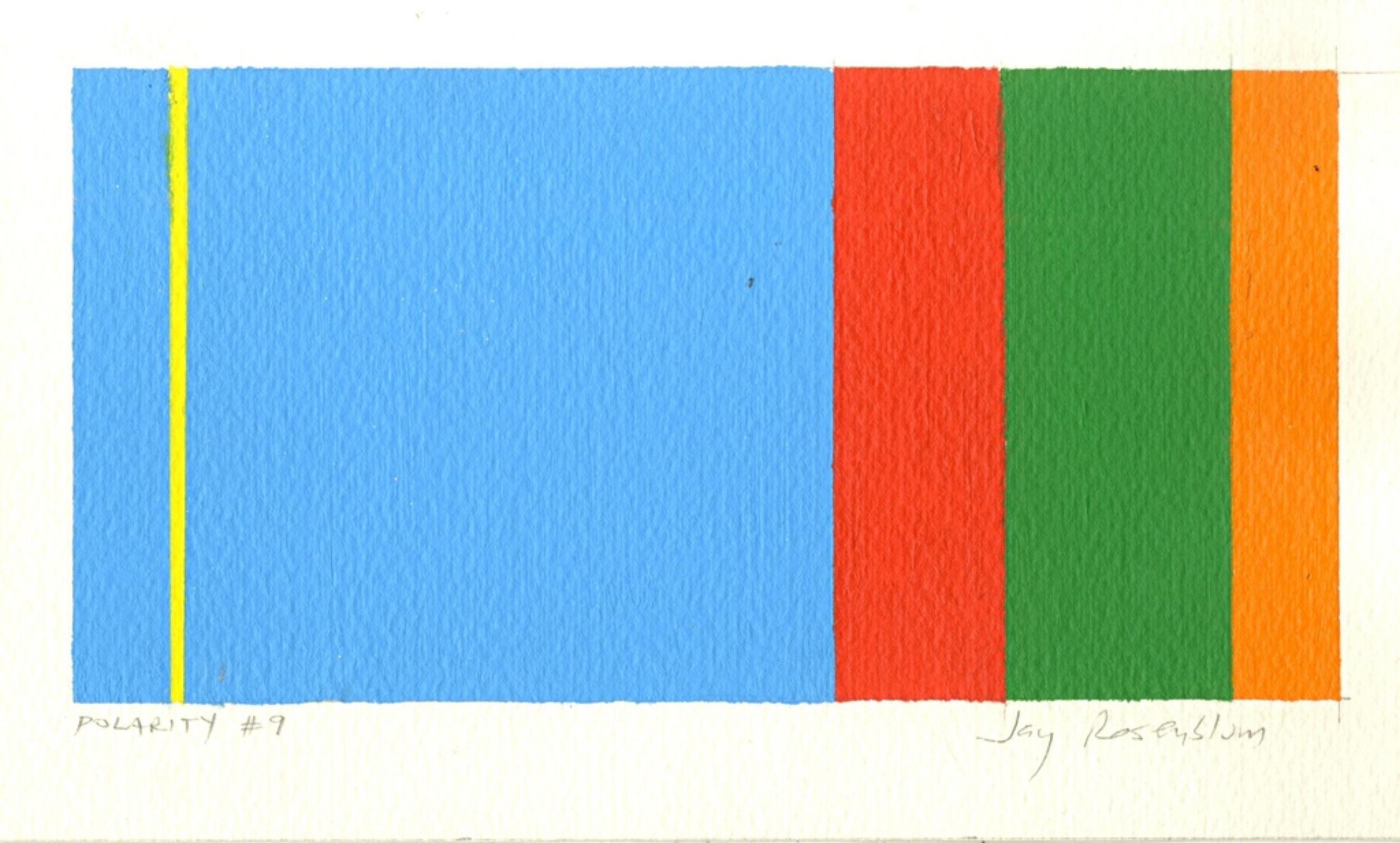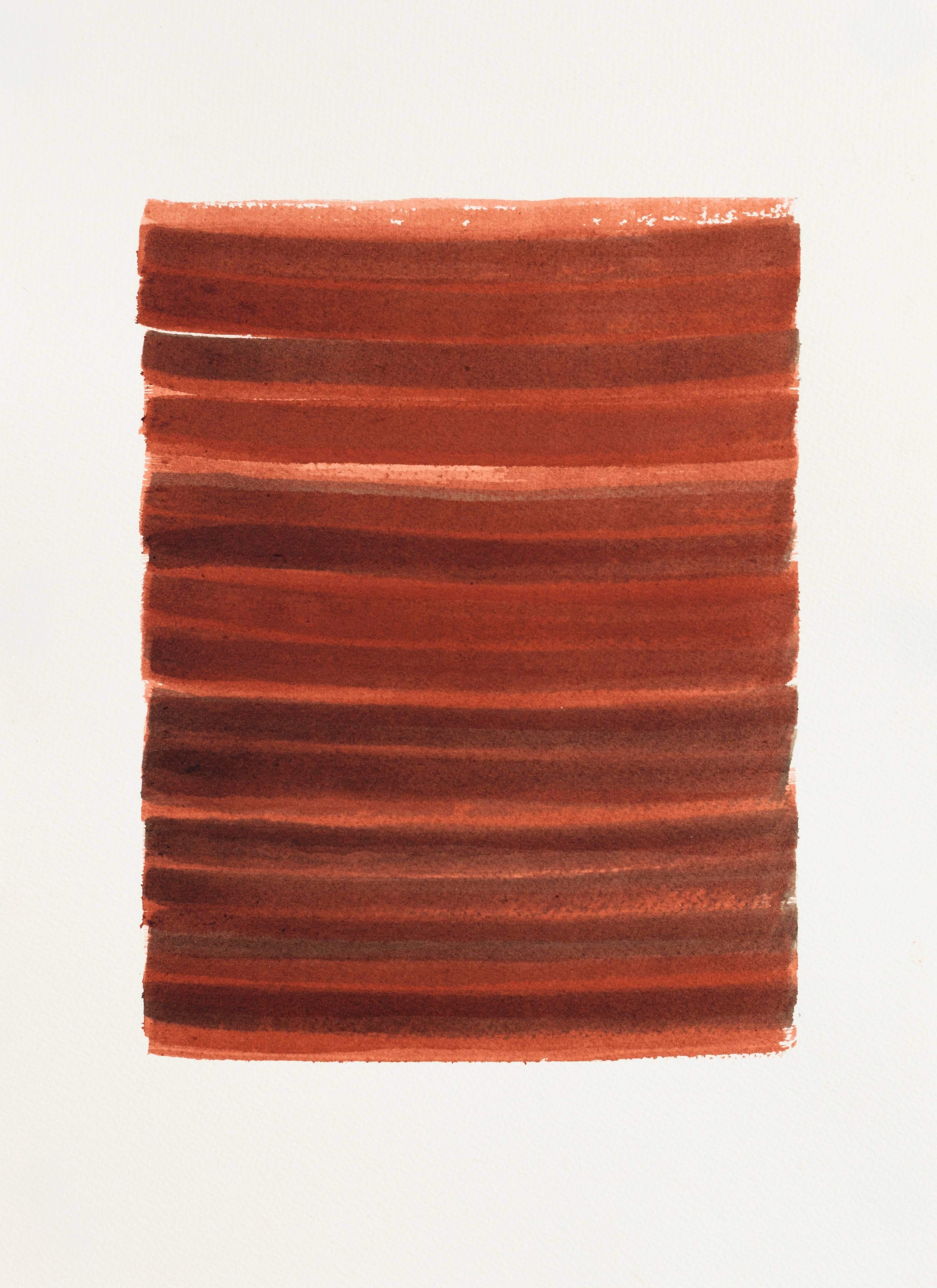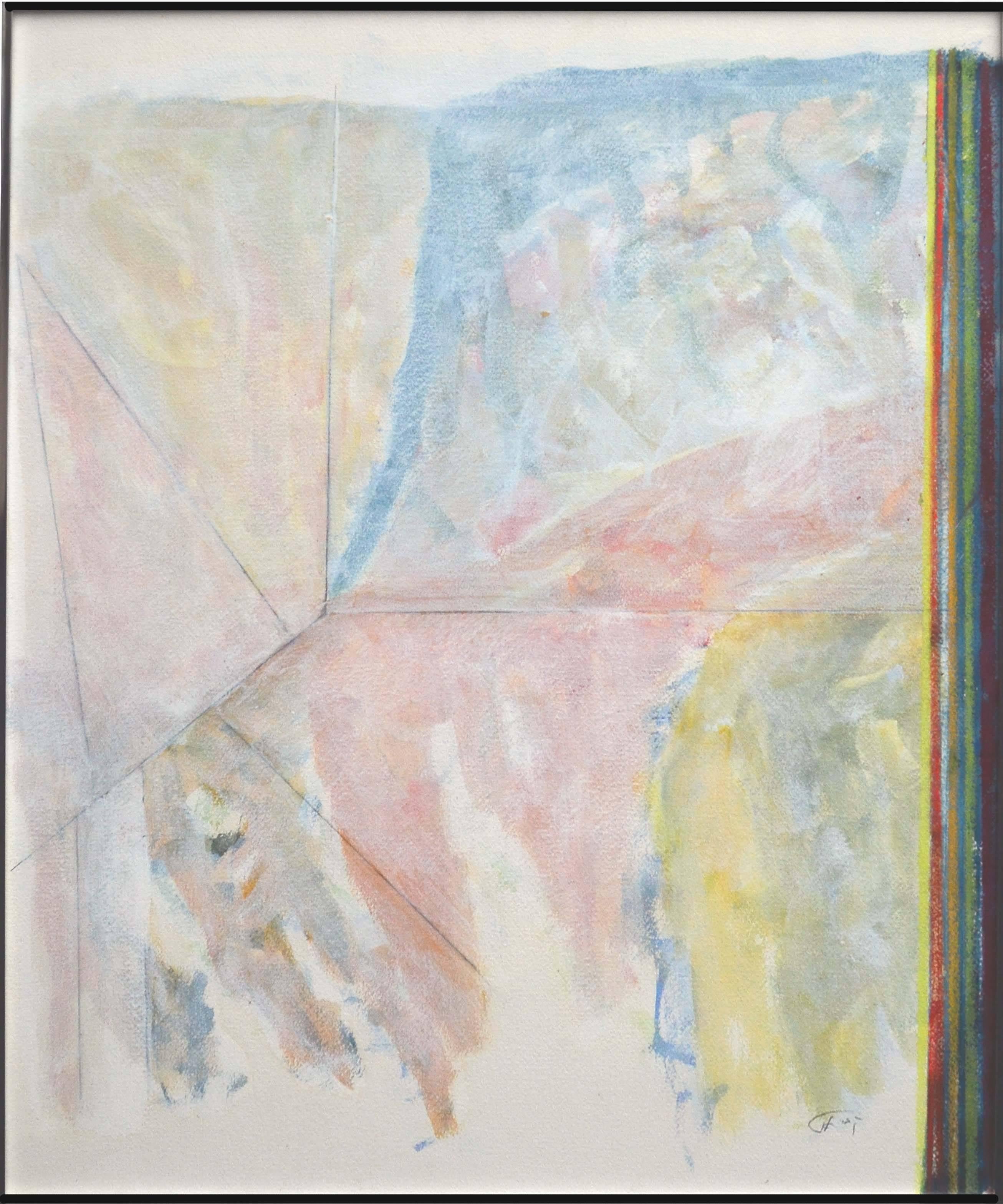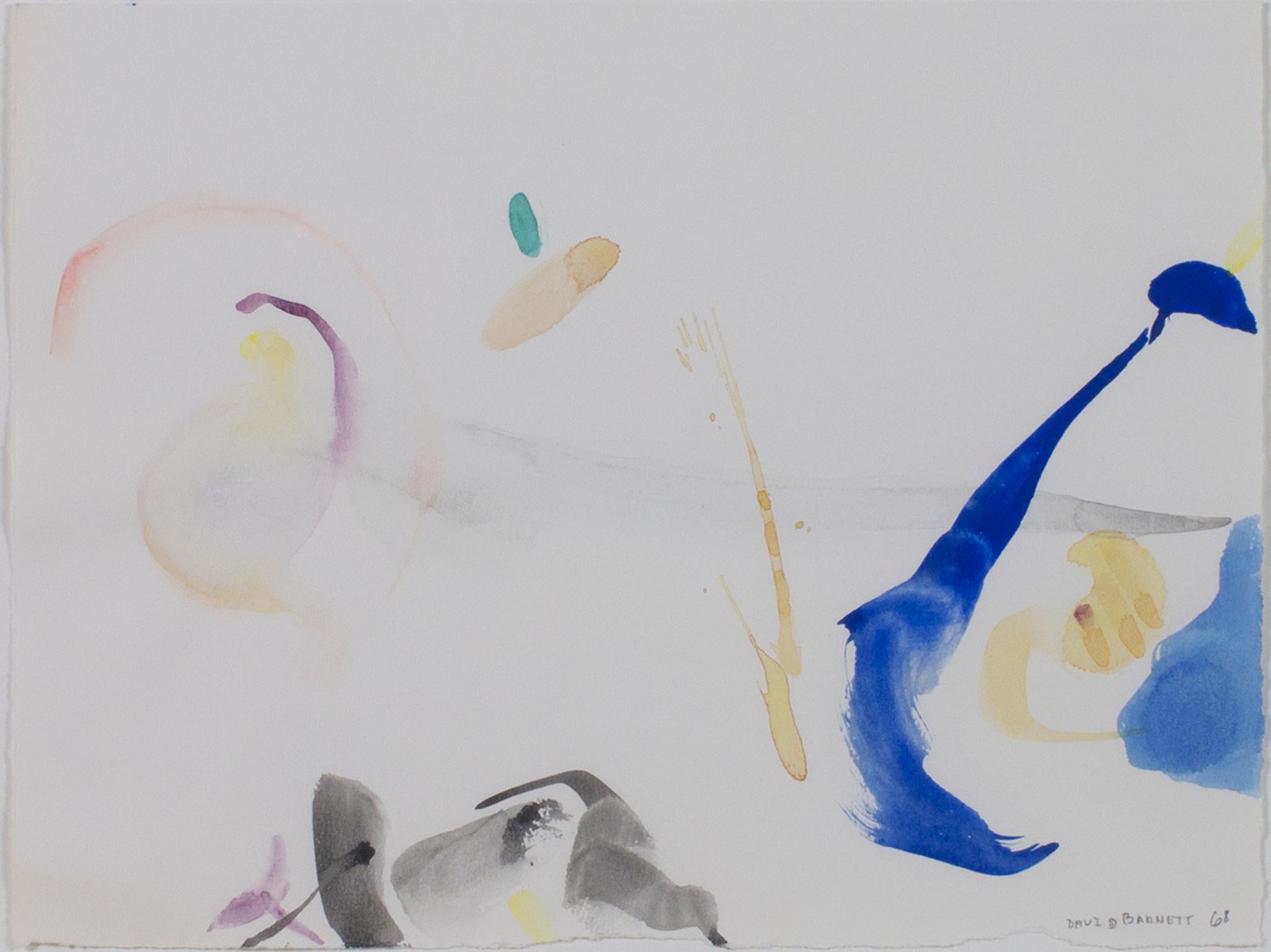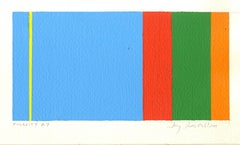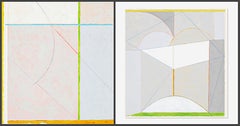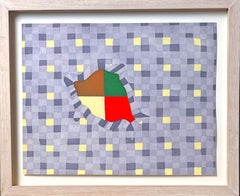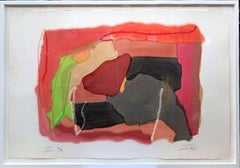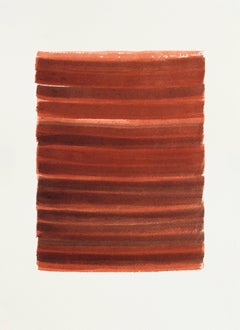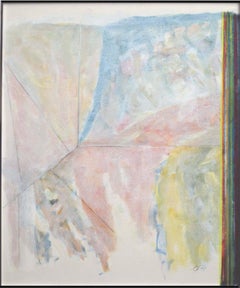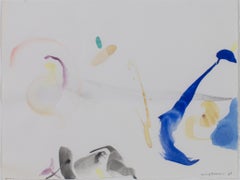Items Similar to Polarity #3 - unique, signed watercolor on paper abstract geometric color field
Want more images or videos?
Request additional images or videos from the seller
1 of 2
Jay RosenblumPolarity #3 - unique, signed watercolor on paper abstract geometric color field1981
1981
$2,500
£1,907.57
€2,170
CA$3,510.81
A$3,842.16
CHF 2,030.24
MX$45,858.71
NOK 25,908.44
SEK 23,695.38
DKK 16,208.78
About the Item
Jay Rosenblum
Polarity #3, 1981
Acrylic on paper
6 × 9 1/2 inches
Signed and titled in graphite pencil on the front
Unframed
This gem of a work is an acrylic painting on paper by renowned Abstract Color Field painter Jay Rosenblum (1933–1989), featuring his trademark bold and dramatic color stripes done with a paint roller.
Jay Rosenblum, a gifted musician and talented painter, coined the term “Free Association Color Development” to describe his vibrant and expressive color block paintings. Based on his love of Classical music, he felt that a painting should come together similar to a sonata, with various notes falling into a synchronistic compilation to create a sensory experience as a whole. He worked with this expressive “visual stripe motif” for over thirty years.
Born and raised in the Bronx, Rosenblum’s life was on a clear trajectory toward the arts from the very beginning. He attended the High School of Music and Art, then went on to receive his Bachelor’s from Bard College, finally studying at Cranbrook Academy of Fine Arts. His creative talents were not limited to 2 or 3D work, he was also a gifted violinist, and played with the Seventh Army Symphony in the 1950s. In addition to making work, he also had an extensive teaching career, molding young minds at the Visual School of Arts, the Cleveland Art Institute, and Hunter College.
Rosenblum was awarded the Carlos Lopez Memorial Prize in Painting from the Detroit Institute of Art in 1955, as well as the Painter of Year Award from Larry Aldrich in 1970. He was also selected to design and execute two major murals in New York City.
- Creator:Jay Rosenblum (1933, American)
- Creation Year:1981
- Dimensions:Height: 6 in (15.24 cm)Width: 9.5 in (24.13 cm)
- Medium:
- Movement & Style:
- Period:
- Condition:
- Gallery Location:New York, NY
- Reference Number:1stDibs: LU1745210954662
Jay Rosenblum
Jay Rosenblum experimented with different versions of the "Visual Stripe motif" for more than thirty years. In the 1960's he developed a "hard-edge" style with "flat curtain forms" which had a clearly defined vertical emphasis. These colors as in our example move up and down the picture plane. Space is defined by shifts in color passages. As the artist explained in his own words: "The vertical forms in my work serve as the vehicle for color and also become a dramatic means of achieving movement and deep space. This becomes possible through a great variation in the stripe thickness and the sudden emergence or disappearance of a particular band of color when it overlaps another." Rosenblum was an ardent violinist who played for the Seventh Army Symphony in West Germany and who was also an art teacher at the School of Visual Arts. In his art Rosenblum sought to associate his great love for chamber music sonatas with his freely evolving vertical stripes of color. Rosenblum once stated: "When these elements engage themselves in the painting, there is a great visual excitement for me. A kinship with music, in a polyphonic sense, is very strong in that simultaneously one hears lines of "overlapping" music. In some mysterious way the composer can achieve this and it is equally mysterious and effective in painting when it happens." In much the same way that singular notes strung together create music, individual stripes of color together can be transformed into a complete art form. He thus viewed these blocks of color almost as separate notes in a piece of music that that when brought together would be transformed into a cohesive unit, resonating with a playfulness that added interest and energy to the picture. With colors Rosenblum attempted to select ones that when juxtaposed against or near one another would become "an exciting visual discovery". He would refer to such works as "free association color development". Rosenblum executed a number of these "hard-edge" paintings which included groupings of color clusters in both vertical and diagonal motifs. Jay Rosenblum was born in New York City in 1933. He attended the Pratt Institute in Brooklyn from 1951-53, Harvard University in the summer of 1953 and Bard College in Annandale-on-Hudson, NY 1953-1955. He received a M.F.A. from Cranbrook Academy of Art in Bloomfield Hills, MI. His paintings have appeared in numerous selected solo and group exhibitions in the USA and Italy. Rosenblum was awarded the Carlos Lopez Memorial Prize in painting from the Detroit Institute of Art in Detroit, Michigan in 1955 and the Painter of the Year Award from Larry Aldrich, Ridgefield, CT in 1970. He lived and worked in Manhattan for most of his life and sadly died in a tragic bicycle accident in 1989.
About the Seller
5.0
Gold Seller
Premium sellers maintaining a 4.3+ rating and 24-hour response times
Established in 2007
1stDibs seller since 2022
471 sales on 1stDibs
Typical response time: 1 hour
- ShippingRetrieving quote...Shipping from: New York, NY
- Return Policy
More From This Seller
View AllPolarity #9 unique signed color field abstract color painting on paper - a gem!
By Jay Rosenblum
Located in New York, NY
Jay Rosenblum
Polarity #9, 1981
Acrylic on Paper painting
6 × 9 1/2 inches
Pencil signed and titled on the front
Unique work
Unframed
]This gem of a work is an acrylic painting on p...
Category
1980s Abstract Geometric Abstract Paintings
Materials
Acrylic, Archival Paper
Untitled Geometric Abstraction (unique two sided acrylic and pencil drawing)
By James Rosati
Located in New York, NY
James Rosati
Untitled Geometric Abstraction, 1982
Two-sided Acrylic and Colored Pencil on Paper drawing
Hand signed and dated on lower right front
14 1/2 × 13 1/2 inches
This is a un...
Category
1980s Abstract Geometric Abstract Drawings and Watercolors
Materials
Acrylic, Color Pencil, Mixed Media
Untitled #3, Color Abstract Expressionist Etching and Aquatint Signed/N Framed
By Thomas Nozkowski
Located in New York, NY
Thomas Nozkowski
Untitled #5, 2008
Color etching with aquatint on Hahnemühle paper
Signed, dated and numbered 5/35 in graphite pencil on the back. Bears original Deutsche Bank collec...
Category
Early 2000s Abstract Abstract Prints
Materials
Etching, Aquatint
Dexter's Choice State II, signed mixed media watercolor (unique variant), Framed
By Larry Zox
Located in New York, NY
Larry Zox
Dexter's Choice, State II, ca. 1990
Mixed media, Watercolor pochoir, and Oil stick Wax, Water-Based Crayons, on heavy Arches museum watercolor rag paper with deckled edges
...
Category
1990s Color-Field Abstract Drawings and Watercolors
Materials
Crayon, Mixed Media, Oil, Watercolor, Graphite, Monoprint
Untitled Minimalist painting on paper Signed by pioneering sculptor Lyman Kipp
Located in New York, NY
Lyman Kipp
Untitled drawing, 1993
Unique Colored Ink Drawing on paper with two deckled edges
Hand signed, inscribed and dated by the artist on lower front
26 1/4 × 20 inches
Unframed...
Category
1990s Minimalist Abstract Drawings and Watercolors
Materials
Ink, Oil
Untitled Geometric Abstraction - unique signed and inscribed work -framed
Located in New York, NY
Paul Pagk
Untitled Geometric Abstraction, 1989
Gouache and watercolor on paper
Signed, dated and inscribed "A Jacqueline".
Frame included
Excellent unique work on paper by contempora...
Category
1980s Abstract Geometric Abstract Drawings and Watercolors
Materials
Watercolor, Gouache, Pencil, Graphite
You May Also Like
Emily Berger, Jay #2, 2014, Paper, Ink
By Emily Berger
Located in Darien, CT
These paintings and drawings are based on a structure of repetitive and deliberate gesture that is intuitive but carefully considered. Emily Berger brushes, wipes, rubs, and scrapes,...
Category
2010s Abstract Abstract Drawings and Watercolors
Materials
Paper, Ink
Abstraction #13, Mixed Media Abstract Watercolor on Paper by Alexander Kwiat
By Alexander Kwiat
Located in Soquel, CA
"Abstraction #13", beautiful modernist abstract color field watercolor in pastel hues on paper by Alexander Kwiat (American, b. 1955).
Signed lower right hand corner. Gallery label...
Category
1980s Color-Field Abstract Drawings and Watercolors
Materials
Paper, Watercolor
Untitled III, Acrylic Colorfield Painting on Paper by Jay Rosenblum
By Jay Rosenblum
Located in Long Island City, NY
This acrylic painting on paper was created by New York-born artist Jay Rosenblum. In his art, he seeks to correlate his great love for chamber music sonatas with freely evolving bloc...
Category
1970s Abstract Abstract Paintings
Materials
Paper, Acrylic
"Space Odyssey, " Original Abstract Watercolor signed by David Barnett
By David Barnett
Located in Milwaukee, WI
"Space Odyssey" is an original watercolor painting by David Barnett. The artist signed the piece. This artwork features abstract marks and brushstrokes in blue, purple, gray, yellow,...
Category
1960s Abstract Abstract Drawings and Watercolors
Materials
Watercolor
Untitled XVIII, Abstract Colorfield Acrylic Painting on Paper by Jay Rosenblum
By Jay Rosenblum
Located in Long Island City, NY
This acrylic painting on paper was created by New York-born artist Jay Rosenblum. In his art, he seeks to correlate his great love for chamber music sonatas with freely evolving bloc...
Category
1970s Abstract Abstract Paintings
Materials
Paper, Acrylic
Abstract Color Shape - Watercolor - 1970s
By Leo Guida
Located in Roma, IT
Abstract Color Shape is an original Contemporary artwork realized in the 1970s in Italy.
Original watercolor on paper.
Passepartout is included. Total dimensions: 50 x 35 cm. Imag...
Category
1970s Abstract Abstract Drawings and Watercolors
Materials
Watercolor
More Ways To Browse
Vintage Felt Paintings
Vintage Compilation
Color Block Painting
Black Line Drawings
Parimah Avani
Large Abstract Watercolor
Pencil Geometric Drawing
Jean Lurssen
Jody Rasch
Abstract Floral Watercolor
Used Sea Pen
Original Abstract Pencil Drawings
Ink Drawings Large
Joseph Campbell
Triptych Drawings
Italian Love Art
Shell Watercolor
21st Century Watercolour Artists
